|
COMPARING RED TO APRICOT AND CREAM
I see so many breeder out there calling their apricot and creams, reds. This is probably due to the
popularity of the red and being able to sell these puppies at a higher price due to their color. I am putting up this
page in hopes that people can study these 3 colors so as not to be fooled by unscrupulous breeders. I have collected
color articles on poodles and will post them here along with pictures so help show the difference. The authors
of these articles are posted above and below the article. These articles are older but are very good for defining
color and giving you a good idea of how to get that color.
RED
I have yet to find any red color articles. Most likey because to the fact that red is a more recent
addition to the poodle colors. However you can gain a lot of information from reading the apricot articles and applying
that to red. In those apricot color articles you can see the beginings of the red color.
The red color sprang from the apricot. However is shades darker in color than apricot. Just
because a dog may have reddish ears does not make it a red. I am seeing more and more apricot and even cream poodles
being called reds today.
A red poodle should be irish setter red to dark mahogony all over. Having some variation on color
on the body is permissable as long as its not spotting or sabeling (these may still be reds but are displaying the patterns
of parti colored dogs).
A red should never have lighter patches of apricot intermixed in the red. This would be the red
apricot color.
The breed standard says that liver noses are permissable in reds however not prefered. As reds are
being bred more and more with better quality and conformation in mind we should be breeding away from the liver noses and
toward the gorgeous dark inky black pigment that makes them so stunning.
There are several ways to avoid getting liver colored noses.
1) Breed only to a dark red with correct pigment.
2) Avoid at all costs the red pedigree with brown in it. Breeding red to brown with cause liver pointed
noses
3) You can occasionally throw in a black dog to keep the pigment dark. Now you want to make sure that
there are no other colors in the pedigree of that black dog other than black, and or red and apricot. If the black has
brown behind it you will want to avoid that black as it may accomplish the exact opposite of what you wish to acheive.
The above suggestions also will help to deepend your red color. To achieve nice dark reds with less
chance of fading over the years you will want to avoid breeding to any dog with silver, blue, or white in the lines
at all cost. These colors carry the fading gene and will increase the probabilty of the dog fading.
When breeding some reds and apricots you may expect to get creams occasionally. That can come with the territory.
However for the most part I would avoid cream as much as possible when trying to produce darker reds.
Remember that red IS considered a fading color. That is just the nature of this color. In 99%
of cases you will have reds that fade over time as they mature. The object ofcourse being to breed darker reds that
will keep their color as they get older.
You can also get puppies in some lines of red that will be born apricot or an almost orange color that will
latter mature and darken into reds. Some of these pups will hold their color longer and not fade as badly.
many of the old time red breeders would look for an orange puppy and hold that one back for their breeding
program due to this reason.
Our Mystique has been a great example of the color holding pretty well. It was only this past year
at 7 years of age that she has started to loose a bit of her color and grizzle out. She is, however, still a dark red.
| Dark red toy puppy |
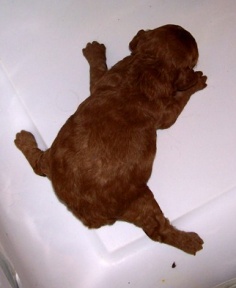
|
| Dark red miniature puppy |

|
| Burnin owned by Betty at Dessormeau Poodles |
| Red adult toy poodle |
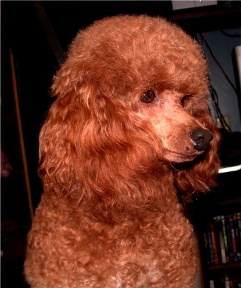
|
| Red adult miniature |
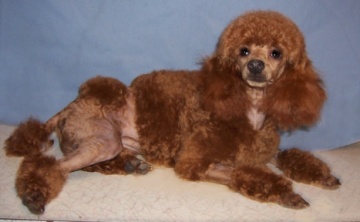
|
RED/APRICOT
As mentioned above it is possible to have both red and apricot colors on a solid colored dog. This is a puppy or dog that is usually lighter than red and has highlights of apricot or apricot tipping.
Almost a swirling combination of red and apricot. Many will look to be almost a glowing orange color. Like flames.
| A Red/Apricot toy puppy |

|
| Red/Apricot toy adult |

|
| Fancy owned by Betty of Dessormeau poodles, bred by us |
APRICOT COLOR ARTICLES
THE CREATION OF APRICOTS
From “The New Complete Poodle by Lydia Hopkins – 1964”
Apricot is still the rarest of the
colors in all three varieties of Poodles, the most difficult to get, and the hardest to care for as it tends to fade in the
sun. It is, at its best, extremely beautiful, and because of this and the rarity of the color, everybody wants to have an
apricot Poodle. Many breeders are trying all sorts of combinations to produce this color, usually most unsuccessfully. It
is not understood, for the most part.
Just as shaded
silver is next to the greatest dilution of black, with pale platinum at the end of the scale, so apricot is next to the greatest
dilution of brown, with cream at the end of the scale. And the relation of shaded silver to platinum is exactly the same as
the relation of apricot to cream. The one slips into the other very easily.
In both creams
and apricots there exist two types-the dogs that have light eyes and brownish or lighter eye-rims, lips, and noses; and the
dogs that have black eyes, eye-rims, lips, and noses. Much latitude has, in the past, been allowed in the matter of eye color
and pigmentation, when this color was rarer than it is at present. But the most expert English breeders of both past and present
agree with me that since light eyes spoil the beautiful Poodle expression so sadly, even in the rarest light colors they are
to be condemned.
Apricot is a term
which, like brown, covers a somewhat wide field of color, ranging from all the shades of gold, from pale to dark orange, and
so on to the true apricot, with a pinkish tinge exactly like the inside of an actual ripe apricot.
At present, apricots
fall into three different classes. First, those that appear in cream lines. These are born rather a deep, clear color like
what in England is called "a ginger cat." These puppies tend to fade later to cream, and mayor may not return to their original
color as they reach full maturity. Second, apricots that come of basically colored lines of brown, silver, and possibly some
black blood. These are, like the silvers, born black and gradually turn lighter, and do not tend to fade unless exposed to
too strong direct sunlight, which no apricot can tolerate. Third, apricots that come from a strongly line-bred family of this
color. These do not fade as readily as the cream-bred apricots, but are still, of course, comparatively rare.
As apricot is definitely
a dilute color, it should, whenever possible, be bred to itself and a certain amount of line breeding should be used. When
this is impossible, it may be crossed with silver, the paler the better, or to extremely light-colored browns. Mating apricot
to black will have one of two alternate effects: either it will bring it up again to brown or, as black is so highly dominant,
destroy it altogether and result in black dogs.
As a classic example
I call the reader's attention to Petite Gina (Family G8), in this book. This will repay a close study, beginning with Petite
Gina’s Standard pedigree with its many line-bred Standard browns. The strain was the noted one of "Whippendell," bred
by Miss Millie Brunker, from which the best English Poodles, both Standard and Miniature, descend. It was noted for its superior
Poodle type. Gina herself was very small for a Standard and cafe-au-lait in color. In her, that noted breeder, Mrs. Tyndall,
saw possibilities, not only to bring type to a Miniature line, but also as a basis for the production of the then practically
unheard-of apricot-colored Miniatures. Long before this, Miss Brunker had produced both true apricots and orange-colored Poodles,
but unfortunately had not been able to keep them long enough to found a strain, as they died young with distemper a number
of years before this experiment was planned. After some thought, Mrs. Tyndall mated Petite Gina to her silver dog, Venda's
Arrow of Silver, and from this union came two bitches, Venda's Chiponque and Venda's Maid in Waiting, the winner of 2 CC's
and the dam of American Ch. Lady in Waiting of Misty Isles. Both bitches were blue. Chiponque was mated to a small black dog,
Jambo, who was later to acquire fame as the sire of Ch. Venda's The Black Imp of Catawba. Jambo carried a brown gene, and
this combination produced two brown daughters, Venda's Jeanette and Venda's Mariette. Jeanette was sold to Mrs. Boyd at Piperscro£t,
and was there mated to the black Monty of Piperscroft and became the dam of the black American Ch. Jingle of Piperscroft.
Mariette stayed at home and Mrs. Tyndall chose for her Leila's (Family Ll) noted son, the blue Venda's Blue Masterpiece. From
this breeding came an exquisite little bitch, practically a unique color of brilliant orange, clear and unshaded like an orange
Pomeranian right down to the skin. Kista's eyes, eye-rims, lips, and nose were black, and she won very well for Mrs. Hoyt
under the name of Ch. Venda's Sunkista of Blakeen. At the same time, Mrs. Hoyt imported her lovely golden daughter, Ch. Venda's
Winter Sunshine, by the small black dog, Petit Morceau of Piperscroft, from a line with some blue blood and possibly also
carrying a brown gene.
Sunshine, like
her dam, Kista, had black eyes and pigmentation. And it
was the union of
Sunshine with her noted kennel mate, Ch. Venda's The Black Imp of Catawba, that was responsible for one of the greatest winning
browns in Poodle history, Ch. Blakeen Eldorado. Eldorado was from a black sire known to carry a brown gene, and a golden-colored
bitch. He was not a dark chocolate brown, but a very brilliant reddish chestnut with eyes the color of garnets, shades darker
than his coat, and very dark pigmentation of eye-rims, lips, and nose. There are examples of this combination in other apricot
pedigrees and also examples where white was used instead of silver but the dogs are less well known and less easy to trace.
Now, in this history
of actual dogs, all of them winners of note, it took two silver crosses in a brown strain to produce an orange, and two crosses
of blacks with brown genes to bring the scale up to a light shade of brown again. Two brown litter sisters were mated, one
to a black which gave a black son, and the other to a blue to produce an orange daughter. And as this history deals with real
dogs and definite facts and is not merely scientific formula, I believe it to be most interesting and instructive.
(The following
material on apricot breeding previously appeared in much the same form in articles I wrote which were published in Popular
Dogs. The material is included here through the courtesy of Popular Dogs Publishing Go.)
I read with great
interest the good and instructive article, " Apricot Poodle Observations," by my good old friend, Hilda Meisenzahl, in the
August 1956 issue of Popular Dogs. Miss Meisenzahl has produced some lovely apricots which nobody admires more than
I do. My special admiration was Yum-Yum, the exquisite little apricot Toy whose untimely death robbed the fancy of so much.
She produced him by breeding two small black, black-bred Miniatures (partly of my breeding), each of which, oddly enough,
must have carried apricot genes. This is extremely interesting and as apricot is recessive, Yum-Yum would have bred true if
he had been mated to another apricot. But, of course, the very small percent of apricots bred in this interesting manner makes
them rare, as most of the puppies are black like their parents.
I am in hearty
agreement with everything in the article with the exception of the opening sentence, and I quote, "There is a mistaken opinion
that breeding brown to silver will produce apricots."
Breeding so for
apricots can be done because it has been done. But not in one generation. The first generation probably would be a mixed,
in-correct color. All the older English breeders - Miss Brunker, Mrs. Tyndall, etc. used either silver or white to dilute
brown to apricot but it was not done in one generation. According to their statements, which were in accord, silver proved
a better dilutant than white for several reasons: first, because using white increased the danger of producing mismarked puppies
and those with coats of weird colors; second, because the whites of that day were not as good type as the blacks, browns,
and silvers; and third, because the apricots from too much white-bred white breeding tended to be too light in color and faded
easily (which our modern breeders of Toys know to their sorrow, and which I shall discuss at length later in this chapter).
Now, no one claims
that mating a brown to a silver or a white, in one generation, will produce an apricot, or that every line is suitable for
such an experiment or every breeder fitted to make it. Our American defect as fanciers is that we expect results overnight
in one generation. The wiser British fancier thinks in terms of from three to five generations and is willing to hope and
wait. Undoubtedly the in-between generations in such an experiment would be anything except apricot, probably most unpleasant
in color. I heartily agree with Miss Meisenzahl that faded, off-shades of browns and silver-fawns, and other undefined colors
are not apricot. It has been too long the habit to call any odd color "apricot," possibly because the true apricot colors
are so rare that people are not familiar with them. True apricot is just what it says the exact color of the inside of a ripe
apricot, pinkish in tone and soundly colored right down to the skin. The ears, especially in young dogs, are usually somewhat
darker but of the same shade, but should not, in my opinion be faulted unless they are an off color or different shade. Within
the scope of this rare color there are several shades, including the sensationally beautiful clear orange like Sunkista, and
various shades of gold from deep old gold to lighter tints. Also, the pinkish apricot may vary from light to dark in tone.
Nearly all apricot litters contain at least one cream, which is natural since cream is just one step down the scale in color
and so closely connected. Many creams of apricot breeding will produce deep colored apricots if bred correctly, either to
an apricot or, as in one case in my experience, to a pale silver. Like all recessives, apricot should be bred to apricot with
as many apricot ancestors as possible. For instance, I have several litters that have two apricot parents, four apricot grandparents,
six apricot great-grandparents, six apricot great-great-grandparents, and six apricot great-great-great-grand- parents. Of
course, this is extremely unusual in a rare color but a certain amount of line breeding to color is necessary to preserve
apricot and to keep the color clear and unshaded. Apricot puppies are born a clear unshaded apricot, some lighter than others
and with or without brown toenails. They are usually darker at birth than they are when mature. There are also apricots which
are born either black or brindle and clear the way silvers do. They have one great disadvantage the colored hair almost never
clears completely on their ears. My experience indicates that such puppies do not occur when both parents are apricot but
only when one of them is a different color. In my decade of breeding apricots I found a number of problems. First of all,
in this rarest of the color types, head type, particularly, has often been sacrificed for the sake of color. The average apricot
tends to have, like the early whites, the ancestral head-thick skull, short foreface, round eyes, and small, flying ears.
Second, those with too much brown blood have very light eyes and pinkish-brown eye-rims, lips, and noses. This is not faulted
in our Standard but it is most unattractive and has kept the apricots from the popularity they so richly deserve. Third, the
correct color is difficult to hold and with too much white or cream blood tends to fade.
Here the problem
was to find a strain (or strains) which will hold color into old age. With the best of imported dogs and bitches woven in
and out, I have been successful in overcoming these handicaps to a great degree. Of course, there is much work to do to fix
the characteristics we have achieved. We have handled about fifty apricot puppies a season as our young bitches matured, and
I imagine we have had more experience than anyone else in America. We have produced almost complete apricot litters, with
perhaps a cream or two. For instance, our Sherwood Tiny Tangerine, bred to Fircot Ray of Sunshine (both apricot), gave us
a family of eight- six apricots and two creams, which is quite a typical litter. The strain is sturdy, sound, and prolific.
I am a lazy soul,
unwilling to go into years of unnecessary experimental breeding involving a great deal of hard work and expense. Neither do
I want an immense turnover of poor, unfit Poodles which would be neither "fish, flesh, fowl, nor good red herring" and which
would be bound to occur en route. I am perfectly willing to accept with thanks the apricot foundation which English breeders
already have built. I feel my contribution to this loveliest of Poodle colors lies in the perfecting of existing strains rather
than in the creating of new ones.
Earlier I made
the statement that apricots with too much white-bred white ancestry behind them tend to fade. A dog like Mrs. Hoyt's famous
Ch. Snow Boy of Fircot, with a famous black sire (sire of no less than eleven black champions) and a gray dam, is vastly different
from a white-bred white of German or French origin with nothing behind it but white dogs for many generations, or the original
white-bred white Toy Poodles. It was this introduction of colored blood, black and its dilutant silver, which accounts for
the splendid Poodle type of the Fircot Miniatures and others bred like them, which includes the majority of our modern white
winners. Blacks and dilute black that have carried the true type from the beginning were generations ahead in sheer type from
the early whites, and, for that matter, even those purebred whites of French and German breeding today. It is from the colors
behind them that the best modern whites derive their beautiful lean heads, oval eyes, long ear leathers and general all-over
excellence of type. White or the complete absence of color is recessive and, like all recessives, breeds true when mated to
dogs of the same recessive color. This fact made Ch. Snow Boy, mated to white bitches, the greatest white sire of his day.
Now, individual whites from colored breeding like the Fircots and others of similar breeding do no harm in apricot breeding.
However, white-bred whites tend to lighten the color and give it a fading
tendency, as breeders
of light colored Toys with a long line of white-bred Toys behind them know to their sorrow.
And what of creams?
Creams, unlike whites, do not lack pigmentation and are genetically far different from whites, being the furthest dilution
of brown, just a step below apricot in the color scale and closely related to it. Creams always appear in apricot strains.
And with the advent of so many very beautiful cream dogs, this color is beginning to be more appreciated and understood. One
thing has not been clearly stated or under- stood until quite lately. This is that creams may fade to such an extent that
they appear to be ice white. This, I'm sorry to say, has been helped by the dislike of the color on the part of many breeders
and handlers of the past who would look at a beautiful cream dog and say, "Oh well, it can be bleached white," which has always
irritated me, since I've always thought cream a lovely soft color in its own right. But without any artificial aid some creams
fade of themselves.
Professor Whitney's
examination of white hair from a number of white breeds revealed the presence of minute color globules in some of the hairs
of apparently pure white dogs. Commander Hinton, in his column in the English Our Dogs) tells of considerable work
done by British breeders on this subject. This shows that many white Poodles that look white are in reality faded creams and
not genetically pure white at all. He believes, after a great many years of breeding whites exclusively, that the puppy that
is whelped cream and later turns white is simply a faded cream. My own experience bears this out. Therefore, since I think
cream is a beautiful color, I try my best in my breeding operations to produce creams that are deep and rich of color and
not a washed-out hue. By the same token, I want my whites to be a glistening, snowy white like something off a wedding cake.
I also class any puppies whelped cream as creams, regardless of how white they appear later in life.
The two terms "white"
and "cream" should not be used loosely and incorrectly as they so often are. It can be seen that they are absolutely different
colors, though both recessive-one the total absence of color, the other the furthest dilution of brown.
Professor Whitney's
summary and conclusion after the examination of hair samples of a number of white breeds, including white Poodles, stated,
"The Poodles with icy white coats belong to the black hair type, those with warmer tones in their white coats belong to the
yellow hair type. Corroborated by microscopic examinations and breeding reports." The black haired type have dark eyes and
black eye-rims, lips, and noses. Those of the yellow type have light eyes, and brown eye-rims, lips, and noses in the case
of apricots and creams. All creams and apricots with dark eyes, eye-rims, lips, and noses, have a predominance of black haired
inheritance. Thus,
scientific data
confirms the experience of practical breeders. It is, of course, obvious that white dogs of colored breeding that carry even
a tiny amount of color even in a few hairs of their coat are not genetically white, and undoubtedly carry cream and probably
apricot genes as well.
I hope the foregoing
will clarify the situation as far as apricot breeding is concerned and show clearly that white, white-bred whites are harmful
in apricot breeding, although individual whites of colored ancestry are not; and that creams are not just impure, incorrect
whites but a color in their own right and closely related to apricot.
From “The
New Complete Poodle by Lydia Hopkins – 1964”
_____________________________________________________
Apricot By Mrs Hoyt – The Book of the Poodle 1982
A
vivid bright color on the tone of the actual fruit, but usually lighter by several degrees; a brilliant tan with an overlay
of pink. Not to be confused with cafe-au-lait. Eyes are dark brown, but may be almost black or a dark reddish brown.
Eyerims, nose, lips, and toenails are black. Skin is a matching shade of pinky tan several degrees darker than the coat. Sometimes
the skin is blue or gray.
Common Faults: Such dogs may have blue or black hairs throughout the coat, a minor
fault that need not trouble the breeder. If there are real black patches and spots the
breeder may be doubtful about
the color in future puppies.
Such dogs may have ears much darker than the body coat, almost rust-colored. Provided
they are in tone with the body coat, this is a very minor fault.
Such dogs may have dark gray or blue ears. This is
a definite show fault but need not trouble the breeder. My apricot Champion Vendas Sunkista of Blakeen had blue ears, but
her apricot daughter, Champion Vendils Winter Sunshine of Blakeen, did not.
Such dogs are often darker in the ruff
or main coat than in the saddle or pack. This is hardly a fault because this color is most inclined to fade. Such dogs may
show lighter, almost white, at the roots of the hair. This is a minor fault which indicates that the dog will not long hold
its color .
Such dogs often fade to a strange pinky cream, almost a white but not a good white. If the tone is even
this is not a fault, but it does not look well in the show ring. It need not trouble the breeder.
Such dogs are sometimes
streaked with darker tones and light, almost white, tones. This is a major fault, although such an apricot is still useful
for breeding.
Question: Is this a true color?
Answer: Yes, and the puppies are whelped this
color. It must not be confused with brown or cream.
Question: In this color, which is preferable, brown or
black eyes, eyerims, nose, lips, and toenails?
Answer: We consider black eyerims, nose, lips, and toenails
and dark brown, almost black, eyes to be correct. The lighter pigment is acceptable in the show ring, but the darker is to
be preferred. When an apricot has brown points, it indicates that brown or cafe-au-lait crosses have been used in its background
and it is not as true an apricot.
Question: Is it easy to establish a line of apricots?
Answer:
We do not think so, and very often in such a line the type is sacrificed for the color . The Honorable Mrs. Nellie Ionides
and Miss Jane Lane produced some excellent Standard apricots of good type and color in England. These apricots, however, did
not establish a line. That is, their apricot progeny could not be counted upon to produce this color. In this country apricots
are apt to fade to a very poor tone. I have had several whole litters of apricots in my kennel, the Miniatures, and I did
not keep any. The type was not good enough, and I was afraid that they would fade at two or three years old.
Question: Is this color popular in the show ring and with the public?
Answer: When not faded
it is sensational in the show ring. In fact, apricots of second-rate type, and even sometimes mismarked, have won on coloring
alone. My apricot Miniature Champion Vendas Sunkista of Blakeen had blue ears, but the first time shown she went Best of Winners
at Westminster under an excellent judge. She did have fine type, was very sound, and was a wonderful little showman. She carried
a superb coat of texture. Still there were those blue ears! She never was defeated by one of her own sex and could have done
much more winning than she did except that as soon as she gained her title I stopped showing her. The ears embarrassed me.
The public also loves this color when it is not faded. But when it fades, as it so often does, the owners are very disappointed.
This is because the faded color is not attractive, being a sort of dirty pink or white. Of course the more delicate colored
apricot puppies are not popular with the public, as they are just considered a poor white.
Question: What is
the best color to use in breeding away from apricots?
Answer: White bred to apricot usually produces true creams
and sometimes whites. Brown bred to apricot will produce brown or black unless the brown or black should happen to carry apricot.
The black Miniature Champion Vendas The Black Imp of Catawba was bred to the apricot bitch, Champion Vendas Winter Sunshine
of Blakeen, and produced the sensational chestnut brown Champion Blakeen Eldorado. Eldorado, of course, produced blacks when
bred to blacks and browns when bred to browns. He never produced an apricot, a blue, or a gray, nor did his black brother
and sister . Yet Sunshine was a daughter of the apricot Sunkista and a blue, but Imp and Sunshine were related on their brown
and black side.
Question: What are the least advisable colors to use with apricots?
Answer: Black,
blue, or gray of mixed color heritage, and cream. If apricot is bred to black, blue, or gray of mixed color heritage, mismarks
and parti-colors may result; also brindle and the black and tan pattern appear frequently in this type of cross. Cream will
produce poor whites or streaky creams.
Question: What is the best way to establish an apricot line?
Answer:
Most of the best apricots were bred by chance or from at least one apricot parent. In order to start an apricot line
we would say that you must have at least one apricot dog. If you have a Standard you should not have too much trouble
finding a mate for it of the same color . Try to stick to this color. If you have a Miniature you may have more difficulty.
If you must make a cross, use a black, blue, or gray that is known to carry apricot. If you cannot find such a dog, try to
find one of as pure as possible color heritage. Breed this to your apricot, then breed one of the progeny back to the apricot
parent. In doing the latter you may have to sacrifice type and temperament for color; also you would probably get some mismarks,
etc. We would not recommend it.
Question: Have there been any great apricots?
Answer: There have
been at least several worthy champions and a few great ones. Champion Frenches Honeysuckle won numerous Bests in Show in England
some years back, prior to importation to the United States, where she continued her winning ways. Miss Cecil A. Ray's Standard
Champion Chloe Riccochet, held a deep, true apricot until he died at 13 years of age. When "Rickey" was clipped down allover
after his show career his color showed no difference. Hilda Meisenzahl established an apricot strain of Miniatures and Toys.
One of the results of her efforts was Champion Meisen Bit O'Gold, an apricot Toy. There was also the sensational Miniature
Champion Pixiecroft Sunbeam, with Groups and Best in Show, and, more recently, Champion Tiopepi Amber Tanya.
Apricot By Mrs Hoyt – The Book of
the Poodle 1982
_______________________________________________
APRICOT By
Mackey J. Irick Jr – The New Poodle 1986
The apricot color has been known in Poodles for more than seventy years. The first Poodle to be registered
as apricot was Whippendell Abricotinette, whelped October 11,1912.
An apricot colored Poodle should be the color of
a ripe apricot. The original apricots just happened, from the mixing of many different colors and they did not breed true
consistently. It has taken many years to stabilize the color and finally apricot lines have been established which will produce
true apricots generation after generation.
The apricot Miniatures and Toys in England and America for the most part
are descended from a deep apricot dog named Aureolin of Toytown, whelped September 25, 1941. Aureolin was by the cream Whippendell
Petit Eclair (Whippendell Duvet ex Nunsoe Sixpence) out of an apricot Bechamel of Toytown (Paul of Toytown ex Whippendell
Bambinette ). English breeders interested in apricots bred to Aureolin and this is the strongest continuing apricot line in
existence today. The English apricots of Venda 's, Frenches, Fircot, Puckshill, DeRegis and Greatcoats all trace back to Aureolin
not once but many times. In this country the Aureolin influence has been spread in Toys through his linebred descendent Midas
of Greatcoats as outlined in the Adam of Evesgarden male line chart. These include the American Toy kennels: Beaujolais, Little
Bit, Secota, Spinnerin and Ounce O'Bounce.
Successful apricot breeders agree that apricots should be kept pure. The
introduction of any other color presents problems. Breeding to blacks usually results in the apricot being covered completely.
Breeding to browns introduces the danger of unattractive brown noses and points. Breeding to pure whites poses the problem
of white chests and toe markings or even a dark apricot line down the back of a cream dog. Much is lost and little gained.
Hilda Meisenzahl's Meisen strain was one of the earliest and most successful in this country. She was emphatic in
stating that apricots should only be bred to apricots, and that by doubling the apricot genes the color will deepen.
Mrs.
Myles Dobson's Puckshill Kennels in England bred Eng. Ch. Oakington Puckshill Ambersunblush who won Best in Show at Crufts
in 1966. She recommends, "Start with a good apricot bred apricot bitch, the purer the line the better. If you can stick to
this color they will get deeper through each generation. All white should be eliminated."
Both Miss Meisenzahl and
Mrs. Dobson have been most generous in sharing their own experiences for the betterment of this beautiful color .
In
Miniatures the original Aureolin influence has been equally as great in the United States through Ch. Woodland Burning Bright,
his son Ch. Marjoe's Tangerine Tiger, and his son Ch. Lyca's Dime Store Novel. Novel was the leading Poodle sire, all varieties,
for 1983.
Only those persons who have actually bred apricots can appreciate the triumph of this accomplishment.
And now having achieved so much and in the never ending quest for an impossible dream, a few apricot breeders have embarked
on the task of breeding good quality reds. Evidently many of the same rules apply-breed color to color, always trying to improve
type. They have already met with a degree of success. The solid red Toy Ch. Jodan 's Red Pepper is a Best in Show winner and
is a multiple champion producer .
APRICOT By Mackey J. Irick Jr –
The New Poodle 1986
________________________________________________
APRICOT POODLES
By Lester H. Martin – This is The Poodle - 1960
There are differences of opinion concerning the color of apricot Poodles. Some dog
fanciers speak of them as being of yellow-orange-tan shades, ranging from pale cream to a very light russet color, with black
noses; others say that they should have the color of a ripe apricot, with black noses.
Black-nosed
Apricots
The
black-nosed apricots have dominant genes for black which begin to develop black pigment in the skin and hair of the unborn
puppies, but their influence is soon counteracted by another set of genes, the apricot genes, that change .the black pigment
to a red-tinted apricot color. The puppies are born with apricot coats; have black noses and bluish skins.
In
addition to the genes for black and apricot, there may be a third set of genes which may begin to function to cause the apricot-colored
pigment to change to pale shades of cream, called chamois by the English. When these three sets of genes are present
some of the puppies of a litter may be born dark or light apricots, and others dark or light creams. (It is often impossible
to distinguish the light apricots from the dark creams). All of the puppies, apricots and creams, have black noses and are
considered by many fanciers to be the true apricots and creams. Pure lines of black-nosed apricots and creams always produce
the coat and nose colors of their parents. Kennel reports have been received of eight litters by black-nosed parents, four
sires and five dams, totaling 34 black-nosed apricot and cream puppies.
Apricots May
Carry Inactive Genes for Other Colors
Some English breeders have bred their pale apricots and
creams 10 dogs of other colors in an attempt to darken their color. As black is a foundation color in apricots and creams
it can take on recessive genes of other colors and carry them indefinitely in an inactive state. When, however, one of these
inactive genes is passed on to a puppy by its sire, and its recessive mate is passed on by the dam, then, these genes form
a pair and become active in producing their own particular color in the puppy.
Black-and-
Tan Inactive Genes in Apricots
A
fancier may be more surprised when his black-nosed apricot or cream sire and dam produce a litter in which one or two of the
puppies are the ordinary black-nosed apricots and creams, but the other three or four are very dark, reddish black and tan
coloring on the feet, undersides of the body, over the eyes and perhaps in other places, a modified black-and-tan pattern.
The dark parts of the coats are made up of a mixture of black and reddish-black hairs in the ratio of about 1 :3. Soon after
birth, however, the roots and bases of the dark hairs begin to become apricot or cream coats, but with many intermingled black-guard
hairs. In the following months the black hairs are shed and uniform apricot or cream coats are finally completed. Records
of two litters, by two sires and two dams, have been received, having eight puppies, three creams and five dark-reddish blacks,
having the black-and-tan patterns. All had black noses. The darkest ones which were allowed to live were changing to apricot
colors at 12 weeks, much to the surprise of the owners.
Brown Inactive Genes in Apricots
Any breeder may acquire perfect-colored, black-nosed apricots
and later be astonished to see in the first litter some brown-nosed puppies with the black- nosed ones. Both, however, have
the apricot genes, but in the black-nosed puppies they have been causing a change of color of the black pigment; whereas,
in the brown-nosed puppies they have been causing a change of the color of the brown pigment, producing slightly different
colors. Superficially, the two coats may appear to be alike but a careful scrutiny will show that those of the black-nosed
puppies will have pink tints, giving them warmer tones ; and those of the brown-nosed puppies will lack pink tints in their
dull- brownish coats. A few kennel records show: that five litters, by two black- nosed cream sires and three'similar dams,
contained 19 puppies, 12 with black noses and 7 with brown noses. Brown-nosed Poodles breed true and never produce black-nosed
puppies.
Silver Inactive Genes in
Apricots
The foundation
color in silvers is also black but the apricot genes can change the black pigment in a silver to an apricot or cream color
before the birth of the puppy so one does not suspect that the dog is a carrier of silver genes until proper matings are later
made. One kennel reports a litter by a black-nosed cream sire and a blue dam. Of the four puppies born black, two of them
cleared to silver. A gene for silver must be contributed by each parent for the production of a silver puppy. The
Overpowering Apricot Genes Some people might consider the dominant black pigment genes as the most influential ones, as they
can associate with one or more of the recessive color genes and prevent them from functioning. As the effects of a pair of
apricot genes on other colors are studied, one is reminded of the ancient alchemist whose highest hopes (never realized) were
to be able to change all metals into gold. When the apricot genes become associated with a sparkling black they at once transform
it into a golden apricot with pink tints; a somber brown is readily changed to lovely honey and cream colors but without the
pink tints ; the least desirable color of
black-and-tan
is more resistant to changes, but it is overcome and develops into a typical apricot color; and a gleaming silver is easily
transformed into a delicate cream. There are, however, many variations of color shades in these transformations but their
end results are always in apricots and cream shades.
Black-nosed-
White, Apricot and Cream Matings
Some
of the ordinary white Standard and Miniature Poodles are often considered the last stages of color reduction in creams, retaining
only their black noses and possibly a few hairs on the ears that are slightly tinged with )cream. Theoretically, when such
whites are mated with apricots and creams,
all
of their puppies should be born apricots or creams, as both parents belong in the same color group. One kennel reports a litter
of 11 black-nosed apricot and cream puppies, by a Standard black-nosed dark apricot sire, one puppy was as dark as the sire.
Other kennels report five litters totaling 3 apricot puppies and 20 cream puppies, by three Miniature apricot and cream sires
and four Miniature white dams, all dams, sires and puppies with black noses.
As the genetic background of some of the white Toy Poodles and many of the other
white Miniatures and Standards are different from those of the extremely diluted apricot Standards and Miniatures, their offspring,
by apricots and creams, may be black or of other colors.
Summary
The apricot genes change the color of the black pigment in the coats of black-nosed black, black-and-tan, silver and probably
blue Poodles to various reddish-orange shades; and the color of the brown pigment in the brown-nosed Poodles to various shades
of delicate browns, honey colors and cream puppies.
Acknowledgements
for breeding records and hair samples are made to the following kennels: Nikolane,. Orchard House, Sherwood Hall and Welchacre.
Perhaps
you feel now, as so many other Poodle owners and breeders do, that all Poodle registrations should not only tell the dog's
color but should carry the additional information telling the color the dog was at birth. This would be a great help to serious
breeders. If the kennel clubs which register Poodles could not arrange room on their certificates, surely every pedigree blank,
private or official, should carry the information.
APRICOT POODLES
By Lester H. Martin – This is The Poodle - 1960
_______________________________________
Apricot - Pamela Ingram, Sassafrass Kennels
What color is apricot? It is quite simply the color
of a ripe apricot. I think that the controversy
happens because a puppy may, AS A PUPPY, be the color
of an apricot and yet may fade to be almost white. Then, some breeders feel that anything deeper than a white is an apricot (even as a puppy ) and will be 'surprised' that the puppy 'faded out'. This makes the
real apricot breeders so annoyed that they
start advertising "orange" dogs, "copper" dogs, and
even "fire engine red" dogs.
The color at whelping may be anything from a sandalwood
to an almost brownish red tone. The puppy
should be exactly the same color all over, with no
shadings on chest. Also, that vital place for the color -- breeder to inspect (
between the pads and the back of the pads ) should be as dark as the rest of the coat.
At six wks the color should be very even and a dull
or dark apricot. When the face and feet
are clipped there should be no appreciable difference from the rest of the coat. The top of the head, the whole chest and behind the shoulder blades should not be lighter. The under flaps of the ear should be as dark as the outside of the ear.
During adolescence, the coat should hold the same color
fairly evenly without appreciable layering.
Layering means an inch of dark followed by an inch
of light, then dark, then light, etc. The entire coat of the dog should remain approximately the same color.
The color at maturity depends upon the type and texture
of coat. If it is thick fluffy type of
coat, the dog will start a very little paling all over at 13 to 22 months of age, reaching it's lightest stage at this age, as with a silver. At 2 yrs. of age the coat will start to darken slightly, and get darker with every year. In a fluffy type of coat there is not
much difference between the undercoat and
the jacket hair. In a coarse type of coat
the same thing happens, excepting that the jacket or long ruff hair is much darker appearing than the pack or short pack hair. This is do to the fact that the coarse or guard hairs are filled with fatty pigment,
and being thicker, show more. Approximately
twice a year ( when a new crop of guard hairs
appears ) the pack will be almost the color of the jacket. After 2 yrs. of age the apricots darken increaingly.
Apricots are usually deep in color when whelped and
lighten gradually until the age of two
yrs., when they gradually deepen again. They usually end up the same color basically as the first layering and depending upon how coarse and how long the coat is, the jacket may be many times deeper. However, there are lines of apricots which progressively deepen throughout
their lives. This type will be a dull orangish
or a very deep tan, in color as young puppies.
Both types must have the same color all over. At puppy that is light orange at six wks., with a white face and feet ( and has started to patch at the skin ) will mature into a white with orange guard hairs. If it is a bright or light apricot at that age, it will be a deep cream
with orange guard hairs at maturity. If
you cut this color down, it appears cream,
but when in long show coat it looks a good color. So the longer the hair the deeper the color.
from an article by Pamela Ingram, Sassafrass Kennels
| Apricot toy puppy |
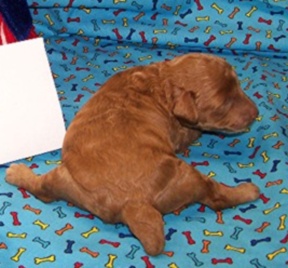
|
| Apricot Toy puppy |
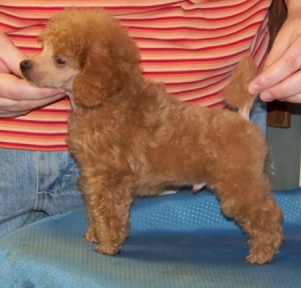
|
| Apricot miniature adult |
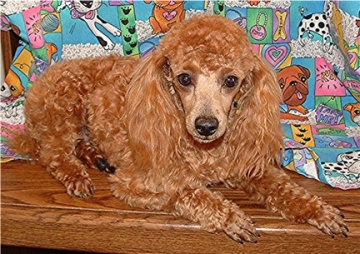
|
| Chili owned by Betty at Dessormeau poodles |
| Apricot toy adult |
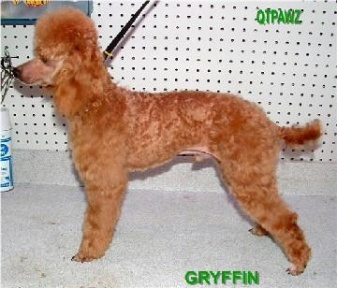
|
| Light Apricot miniature |
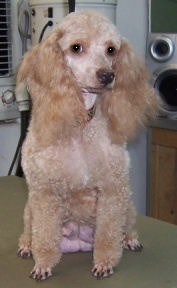
|
| Rosie owned by Betty at Dessormeau poodles |
CREAM COLOR ARTICLES
Cream By Mrs Hoyt – The Book of the Poodle 1982
The color of
good, rich Jersey cream. Not just tan, more yellow in tone and a lighter color than the lightest tan. The eyes are deep, soft
brown; the jet black eye should not appear in a cream, being unbecoming to this color. Eyerims, nose, lips, and toenails are
a very dark brown or black. The skin is blue and sometimes a tawny pink; it , should not be spotted.
Common Faults:
Such dogs may have white toenails. This is a very minor fault and should not worry the breeder.
Such dogs may
have liver nose and eyerims. This, too, is a very minor fault and should not worry the breeder.
Such dogs may have
lemon colored or pale tan ears. This is a fault in the ring but need not disturb the breeder.
Such dogs may appear
streaked in color, such as lemon or pale tan streaks up the back. This is a show fault but need not disturb the breeder.
Such
dogs may have light brown eyes, almost yellow in tone. This is a fault in the ring, and the I breeder should hesitate before
using such a dog. Light eyes are hard to overcome, particularly in light-colored dogs.
Such dogs may fade to almost
a pure white and have, nevertheless, brown rather than black eyes and brown rather than black noses. They often do, and this
is just unfortunate in the ring, as it destroys their chances. It need not disturb the breeder unless he, too, has considered
the dog as a white. The difference between a true white and a faded cream is as follows: The true white has no lemon or pale
tan in the coat. There is no "streakiness" in the coat of a true white, while there is in a faded cream.
Question:
Is cream a true color?
Aryswer: Yes. It is not just a dirty white. The puppies are born cream, sometimes
darker than the adult.
Question: Could one establish a cream line?
Answer: We think one could,
but it would be difficult because creams seldom reproduce the same shade as themselves. They usually tend toward white. We
do not know of a cream line.
Question: What is the best color to preserve cream?
Answer: Another
cream related on the cream, not white, side of the pedigree.
Question: What is the best color to breed away
from creams?
Answer: White.
Question: What colors are not advisable to breed with creams?
Answer:
Black, blue, brown, cafe-au-lait, gray, and apricot, in that order .
Question: Have there ever been any
great show winning creams?
Answer: Indeed there have been, both here and in England. Champion Blakeen Osprey
was a
Cream By Mrs Hoyt – The Book of the Poodle 1982
Group
and Best in Show winner. Champion Braevel Biscuit was another .
Question: Is cream a popular color in the show
ring and with the public?
Answer: Not particularly, as this color all too often is considered a poor white.
it takes an extra good cream to defeat an equally good white, and all too often the inferior white dog defeats the cream.
The color is not as dramatic as the pure white. The public often considers a cream a poor white, thus cream puppies do not
sell too well,
By Mrs Hoyt – The Book of the Poodle 1982
The
color of good, rich Jersey cream. Not just tan, more yellow in tone and a lighter color than the lightest tan. The eyes are
deep, soft brown; the jet black eye should not appear in a cream, being unbecoming to this color. Eyerims, nose, lips, and
toenails are a very dark brown or black. The skin is blue and sometimes a tawny pink; it , should not be spotted.
Common
Faults: Such dogs may have white toenails. This is a very minor fault and should not worry the breeder.
Such dogs
may have liver nose and eyerims. This, too, is a very minor fault and should not worry the breeder.
Such dogs may
have lemon colored or pale tan ears. This is a fault in the ring but need not disturb the breeder.
Such dogs may appear
streaked in color, such as lemon or pale tan streaks up the back. This is a show fault but need not disturb the breeder.
Such
dogs may have light brown eyes, almost yellow in tone. This is a fault in the ring, and the I breeder should hesitate before
using such a dog. Light eyes are hard to overcome, particularly in light-colored dogs.
Such dogs may fade to almost
a pure white and have, nevertheless, brown rather than black eyes and brown rather than black noses. They often do, and this
is just unfortunate in the ring, as it destroys their chances. It need not disturb the breeder unless he, too, has considered
the dog as a white. The difference between a true white and a faded cream is as follows: The true white has no lemon or pale
tan in the coat. There is no "streakiness" in the coat of a true white, while there is in a faded cream.
Question:
Is cream a true color?
Aryswer: Yes. It is not just a dirty white. The puppies are born cream, sometimes
darker than the adult.
Question: Could one establish a cream line?
Answer: We think one could,
but it would be difficult because creams seldom reproduce the same shade as themselves. They usually tend toward white. We
do not know of a cream line.
Question: What is the best color to preserve cream?
Answer: Another
cream related on the cream, not white, side of the pedigree.
Cream By Mrs Hoyt – The Book of the Poodle 1982
____________________________________________
NOTE: You may hear some of the old time poodle
breeders refer to a puppy as champagne in color. AKC removed this color from the poodle color choices years ago.
Champagne is now encompassed into the cream category now.
| Cream miniature puppy |
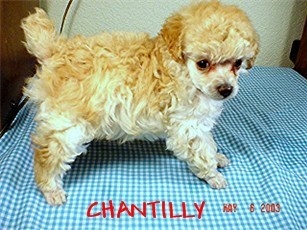
|
| Cream standard pup at 6 weeks |
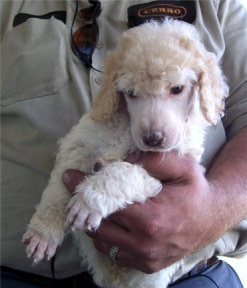
|
| Cream miniature puppy |

|
| Cream standard puppy |
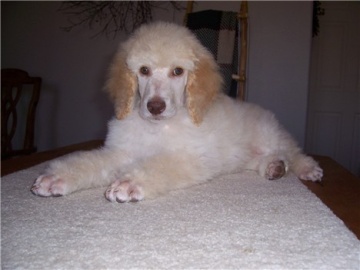
|
| Cream standard young adult |

|
| Cream standard Adult |
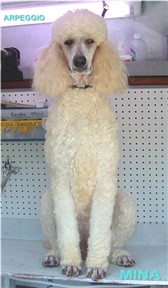
|
| Cream adult standard |
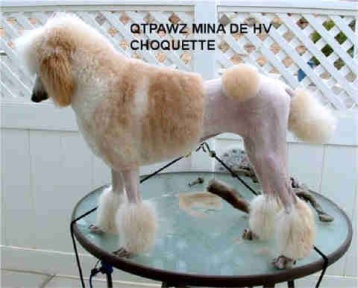
|
| Cream miniature adult |

|
| Buttercup owned by Betty at Dessormeau Poodles, bred by us |
|